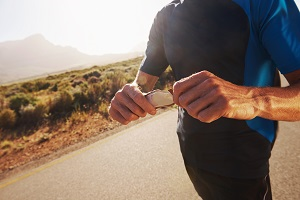MEDIA // ARTICLE

Eating for Endurance Sports
April 20, 2025 at 11:00 AM EST.For endurance sports athletes like competitive swimmers, cyclists and long-distance runners, a common mantra is “food is fuel.” An experienced endurance athlete knows that learning what to eat, and when to eat during an event, is an important part of training. Because long, grueling workouts and events mean burning a ton of calories, energy suppling foods are a must.
That means training your body to accept quarts of sports drinks, water, and “energy gels” in the midst of a hard race. (Energy gels are gels usually based on maltodextrin, which provides glucose to the blood stream and an easily absorbable form of carbohydrate.)
Besides the obvious performance determinant from not consuming the right food, some studies suggest 30 to 50 percent of endurance athletes regularly experience gastrointestinal issues like bloating, nausea and diarrhea. A review published in the journal Sports Medicine suggests one way to prevent such issues is “training your gut.” The idea is that just as your muscles, lungs and heart adapt and respond to extreme exercise, so to can your digestive system.
Researchers concluded training your gut has two basic goals: reducing bloating, and speeding the absorption into the bloodstream of vital energy boosting food and fluids.
There are several ways to achieve both goals. In order to reduce bloating, you need to guarantee that food and fluids leave your stomach quickly. One way to do that is to train immediately after a meal, or while ingesting high volumes of liquid. Both of those actions help speed the emptying of your stomach. It also impacts how full you actually feel, even if there are still liquids in your stomach.
After food and fluids have passed from your stomach to your small intestine, you’ll want to speed its absorption into the bloodstream. Once those items are in your bloodstream, it can quickly be distributed to fuel-depleted muscles. The way to coach your body to do this rapidly is to train while consuming high amounts of carbohydrates. That increases the number of transporters that move carbohydrates across the intestinal wall.
Overall, the best way to train your gut is to simulate all aspects of your race during training. To do so, you’ll have to figure out how much fuel you’ll need.
Races that take more than two hours usually need about 60 grams of carbohydrates per hour, but that’s hard for most people to consume. Racers will need to discover how much carbohydrates they can endure during their training, and then push themselves to consume more and more over a few weeks of practice.
Here are some diet tips gleaned from a study on Kenyan long-distance runners, arguably the “best” overall group of endurance athletes on the planet:
- The study found elite Kenyan runners typically ate five times a day. That included the three typical meals as well as a mid-morning and afternoon snack.
- Most of their nutrients come from vegetable sources, the majority coming from bred, rice, potatoes, porridge, cabbage, kidney beans and ugali (corn-meal paste molded into balls and dipped into various sauces for flavor).
- Meat is reserved for just four times weekly in small amounts- about 3.5 ounces per day.
- They drank a good amount of tea with milk and sugar, every day.
- None of the Kenyan runners featured in the study consumed supplements of any kind: No vitamins, minerals, special formulas, etc.
- Fat intake is limited, with only about 13.4 percent of their daily calories coming from fat (46 grams), and 61 percent of those coming from milk. (Drank in their daily tea.)
- To the surprise of researchers, the Kenyans consume a fair amount of sugar. In fact, one out of every five calories the gold-medal runners eat come from sugar.
- One final note gleaned from the Kenyan runner study: They always eat within one hour post workout.
